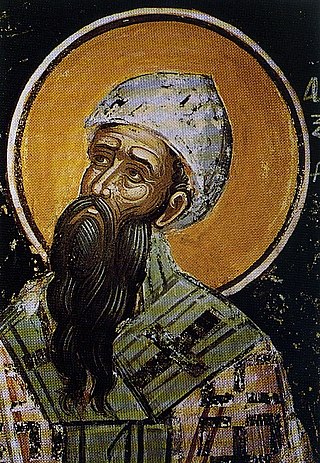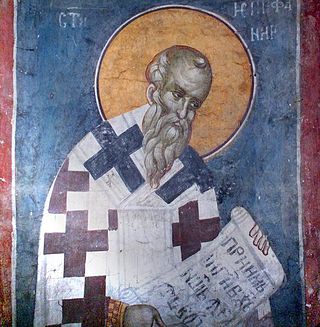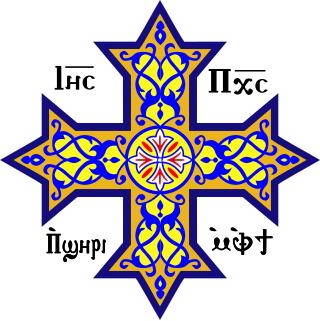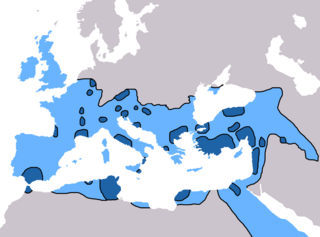Related Research Articles

Cyril of Alexandria was the Patriarch of Alexandria from 412 to 444. He was enthroned when the city was at the height of its influence and power within the Roman Empire. Cyril wrote extensively and was a major player in the Christological controversies of the late-4th and 5th centuries. He was a central figure in the Council of Ephesus in 431, which led to the deposition of Nestorius as Patriarch of Constantinople. Cyril is counted among the Church Fathers and also as a Doctor of the Church, and his reputation within the Christian world has resulted in his titles Pillar of Faith and Seal of all the Fathers. The Nestorian bishops at their synod at the Council of Ephesus declared him a heretic, labelling him as a "monster, born and educated for the destruction of the church".

John Chrysostom was an important Early Church Father who served as Archbishop of Constantinople. He is known for his preaching and public speaking, his denunciation of abuse of authority by both ecclesiastical and political leaders, his Divine Liturgy of Saint John Chrysostom, and his ascetic sensibilities. The epithet Χρυσόστομος means "golden-mouthed" in Greek and denotes his celebrated eloquence. Chrysostom was among the most prolific authors in the early Christian Church.

Origen of Alexandria, also known as Origen Adamantius, was an early Christian scholar, ascetic, and theologian who was born and spent the first half of his career in Alexandria. He was a prolific writer who wrote roughly 2,000 treatises in multiple branches of theology, including textual criticism, biblical exegesis and hermeneutics, homiletics, and spirituality. He was one of the most influential and controversial figures in early Christian theology, apologetics, and asceticism. He has been described by John Anthony McGuckin as "the greatest genius the early church ever produced".

Anatolius of Constantinople was a Patriarch of Constantinople. He is regarded as a saint, by both the Orthodox and Catholic Churches.
Arsacius of Tarsus was the intruding archbishop of Constantinople from 404 to 405, after the violent expulsion of John Chrysostom.
Dioscorus I, also known as Dioscorus the Great, was the pope of Alexandria and patriarch of the See of St. Mark who was deposed by the Council of Chalcedon in 451. He was recognized as patriarch by the Coptic Church until his death. He died in Gangra, Paphlagonia, in September 454. He is venerated as a saint by the Coptic and other Oriental Orthodox Churches.

Epiphanius of Salamis was the bishop of Salamis, Cyprus, at the end of the 4th century. He is considered a saint and a Church Father by both the Eastern Orthodox and Catholic Churches. He gained a reputation as a strong defender of orthodoxy. He is best known for composing the Panarion, a compendium of eighty heresies, which included also pagan religions and philosophical systems. There has been much controversy over how many of the quotations attributed to him by the Byzantine Iconoclasts were actually by him. Regardless of this, he was clearly strongly against some contemporary uses of images in the church.

Aelia Eudoxia was Eastern Roman empress by marriage to the Roman emperor Arcadius. The marriage was arranged by Eutropius, one of the eunuch court officials, who was attempting to expand his influence. As Empress, she came into conflict with John Chrysostom, the Patriarch of Constantinople, who denounced imperial and clerical excess. She had five children, four of whom survived to adulthood, including her only son and future emperor Theodosius II, but she had two additional pregnancies that ended in either miscarriages or stillbirths and she died as a result of the latter one.
Theophilus was the 23rd Pope of Alexandria and Patriarch of the Seat of Saint Mark. He became pope at a time of conflict between the newly dominant Christians and the pagan establishment in Alexandria, each of which was supported by a segment of the Alexandrian populace.

The Synod of the Oak was a provincial synod, held in Constantinople in July of 403, which condemned and deposed John Chrysostom as Patriarch of Constantinople.

Origenism refers to a set of beliefs attributed to the Christian theologian Origen. The main principles of Origenism include allegorical interpretation of scripture, pre-existence, and subordinationism. Origen's thought was influenced by Philo the Jew, Platonism and Clement of Alexandria.
John II was bishop of Jerusalem from AD 387 to AD 417. John II succeeded to the episcopal throne of Jerusalem on the death of Cyril in 386. He was the author, according to an increasing number of modern scholars, of the five Mystagogical Catecheses traditionally ascribed to his predecessor Cyril.

Coptic history is the part of the history of Egypt that begins with the introduction of Christianity in Egypt in the 1st century AD during the Roman period, and covers the history of the Copts to the present day. Many of the historic items related to Coptic Christianity are on display in many museums around the world and a large number is in the Coptic Museum in Coptic Cairo.

In the 5th century in Christianity, there were many developments which led to further fracturing of the State church of the Roman Empire. Emperor Theodosius II called two synods in Ephesus, one in 431 and one in 449, that addressed the teachings of Patriarch of Constantinople Nestorius and similar teachings. Nestorius had taught that Christ's divine and human nature were distinct persons, and hence Mary was the mother of Christ but not the mother of God. The Council rejected Nestorius' view causing many churches, centered on the School of Edessa, to a Nestorian break with the imperial church. Persecuted within the Roman Empire, many Nestorians fled to Persia and joined the Sassanid Church thereby making it a center of Nestorianism. By the end of the 5th century, the global Christian population was estimated at 10-11 million. In 451 the Council of Chalcedon was held to clarify the issue further. The council ultimately stated that Christ's divine and human nature were separate but both part of a single entity, a viewpoint rejected by many churches who called themselves miaphysites. The resulting schism created a communion of churches, including the Armenian, Syrian, and Egyptian churches, that is today known as Oriental Orthodoxy. In spite of these schisms, however, the imperial church still came to represent the majority of Christians within the Roman Empire.

The Church Fathers, Early Church Fathers, Christian Fathers, or Fathers of the Church were ancient and influential Christian theologians and writers who established the intellectual and doctrinal foundations of Christianity. The historical period in which they worked became known as the Patristic Era and spans approximately from the late 1st to mid-8th centuries, flourishing in particular during the 4th and 5th centuries, when Christianity was in the process of establishing itself as the state church of the Roman Empire.
Christianity is an Abrahamic monotheistic religion based on the life and teachings of Jesus as interpreted in the Bible. It is the largest religion in the world, with 2.4 billion people, known as Christians, that adhere to the religion.

Eusebius of Cremona was a 5th-century monk, pre-congregational saint, and disciple of Jerome.

The Origenist crises or Origenist controversies were two major theological controversies in early Christianity involving the teachings of followers of the third-century Alexandrian theologian Origen.
Isaac of the Cells was an Egyptian Christian monk who lived during the 4th and 5th centuries in Nitria, Lower Egypt. He was one of the Desert Fathers.
References
- ↑ "Pope Theophilus and the Origenists".
- ↑ Prat, Ferdinand. "Origen and Origenism".
- ↑ Palladius, vii; Socrates, op. cit. For Jerome's congratulations to Theophilus see Jerome, Epistle lxxxvi.
- ↑ Herbermann, Charles, ed. (1913). . Catholic Encyclopedia . New York: Robert Appleton Company.
- ↑ Ward, Benedicta (1984). The sayings of the Desert Fathers: the alphabetical collection. Kalamazoo, MI: Cistercian Publications. ISBN 0-87907-959-2.